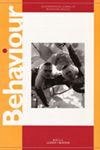Tongue-flicking: an idiosyncratic displacement behaviour in a free-ranging and urban-dwelling population of Balinese long-tailed macaques
IF 1
4区 生物学
Q4 BEHAVIORAL SCIENCES
引用次数: 0
Abstract
This brief report describes the occurrence of an idiosyncratic behaviour, labelled tongue-flicking, that was performed by one subadult male long-tailed macaque living in a free-ranging population in Bali, Indonesia. Tongue-flicking may serve a similar purpose as a displacement behaviour in which the subject sticks his tongue out of his mouth and moves it either slightly up and down or in and out without bringing it all the way back into the mouth. Additionally, while abnormal behaviours in non-human animals are almost exclusively reported in captive individuals, the investigation of idiosyncratic behaviours such as tongue-flicking allows us to explore the potential occurrence of abnormal behaviours in free-ranging populations. This preliminary descriptive analysis of tongue-flicking aims to highlight the need for understanding the motivational bases and affective implications (e.g., welfare) of abnormal behaviours in captive and free-living animals.舌弹:巴厘岛长尾猕猴在自由放养和城市居住种群中的一种特殊位移行为
这份简短的报告描述了印度尼西亚巴厘岛一只生活在自由放养种群中的亚成年雄性长尾猕猴的一种特殊行为,称为甩舌头。弹舌头的目的可能与一种位移行为类似,即受试者将舌头从嘴里伸出,轻轻地上下或进出,而不会一直回到嘴里。此外,虽然非人类动物的异常行为几乎只在圈养个体中报道,但对弹舌等特殊行为的调查使我们能够探索自由放养种群中异常行为的潜在发生。这项对舌头弹动的初步描述性分析旨在强调理解圈养和自由生活动物异常行为的动机基础和情感含义(如福利)的必要性。
本文章由计算机程序翻译,如有差异,请以英文原文为准。
求助全文
约1分钟内获得全文
求助全文
来源期刊

Behaviour
生物-动物学
CiteScore
1.80
自引率
7.70%
发文量
44
审稿时长
3 months
期刊介绍:
Behaviour is interested in all aspects of animal (including human) behaviour, from ecology and physiology to learning, cognition, and neuroscience. Evolutionary approaches, which concern themselves with the advantages of behaviour or capacities for the organism and its reproduction, receive much attention both at a theoretical level and as it relates to specific behavior.
 求助内容:
求助内容: 应助结果提醒方式:
应助结果提醒方式:


